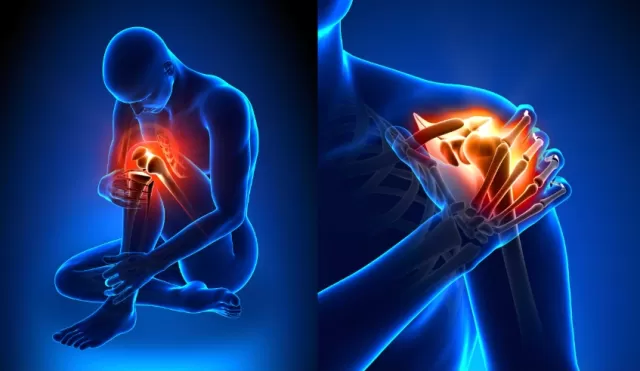Recognizing Signs from Headaches to Fatigue. Whether grappling with short- or long-term inflammation, attentiveness to your body is crucial for prompt recognition of symptoms and initiating a swift road to recovery. Doctors highlight some common manifestations of inflammation and potential underlying causes to enhance awareness.
Symptoms of inflammation may vary but often include redness, swelling, and warmth in affected areas. Pain is a common indicator, presenting as aching or throbbing sensations. Fatigue can signal the body’s heightened energy expenditure in fighting inflammation. Skin changes, such as redness, itching, rashes, or hives, may emerge as visible signs.
For those with inflammation in the lungs, difficulty breathing, wheezing, coughing, and shortness of breath can manifest. Headaches and migraines may also be linked to inflammation, potentially resulting from the release of inflammatory chemicals like prostaglandins.
By heeding these signs and understanding potential causes, individuals can proactively address inflammation and embark on a journey toward recovery. Timely recognition and targeted interventions play a pivotal role in managing inflammation and fostering overall well-being.
Pain as a Signal of Inflammation: Insights from Dr. Medhat Mikhael

When your body experiences inflammation, pain often accompanies it, serving as an initial warning sign that something is amiss.
Dr. Medhat Mikhael, a pain management specialist and the medical director of the non-operative program at the Spine Health Center at MemorialCare Orange Coast Medical Center in Fountain Valley, California, sheds light on the nature of this pain.
In acute events, the pain associated with inflammation may manifest as a burning sensation, while in more chronic cases, it can present as a persistent ache or throbbing discomfort.
Dr. Mikhael emphasizes that the resolution of pain typically aligns with the subsiding of the inflammatory process.
Acute instances of inflammation can often be managed through rest, ice, immobilization, elevation, and the potential use of natural anti-inflammatories like ginger, curcumin, omega-3 fatty acids, and garlic. Non-steroidal anti-inflammatories may also be employed.
However, for chronic inflammation, such as that seen in autoimmune disorders, a more comprehensive approach is often necessary.
Long-term management may involve the sustained use of non-steroidal anti-inflammatories, corticosteroids, immunosuppressant drugs, painkillers, and extended periods of physical therapy. Dr.
Mikhael’s insights provide a nuanced understanding of the relationship between inflammation and pain, highlighting the importance of tailored approaches for acute and chronic cases.
Understanding Fatigue in the Context of Inflammation: Insights from Dr. Denise Pate
Fatigue becomes a notable companion to inflammation due to the substantial energy expenditure required by the body in its fight against inflammatory processes.
Dr. Denise Pate, an internal medicine physician and the medical director with Medical Offices of Manhattan, sheds light on the various factors that can contribute to this inflammation-induced fatigue.
In cases where the body is grappling with inflammation, whether triggered by an infection, food intolerance, or autoimmune disorder, individuals may experience heightened feelings of fatigue even if they are getting adequate sleep.
Dr. Pate emphasizes the importance of recognizing inflammation as a potential culprit for persistent drowsiness.
To address inflammation-induced fatigue, Dr.
Pate recommends prioritizing ample rest, allowing the body the time and Resources it needs to combat the inflammatory response. Additionally, she suggests incorporating anti-inflammatory foods into one’s diet.
These may include fresh fruits, vegetables, nuts, and healthy fats, which can contribute to the overall well-being of the body and potentially mitigate the impact of inflammation-related fatigue.
By acknowledging the link between inflammation and fatigue, individuals can adopt holistic strategies that encompass both adequate rest and nourishment to support their bodies in managing inflammatory processes more effectively.
Dr. Pate’s insights offer valuable guidance for those navigating the complex interplay of inflammation and energy levels.
Skin Changes Indicative of Inflammation: Insights from Dr. Vasilev

Inflammation manifests not only internally but also on the surface of the skin, giving rise to noticeable changes such as redness, itching, rashes, and hives.
Dr. Vasilev emphasizes that these skin symptoms serve as signals that the body is actively combating inflammation, which may stem from various sources, including infections, autoimmune disorders, or allergic reactions.
According to Dr.
Vasilev, these skin changes may manifest locally or become more widespread, indicating a broader issue within the body, such as an allergic reaction triggered by something ingested. To effectively address inflammation-related skin changes, Dr.
Vasilev recommends a systematic approach to identify and mitigate underlying causes.
The potential culprits for skin-related inflammation are diverse, ranging from certain medications to topical Skincare Products.
Identifying these triggers is crucial for developing targeted strategies to reduce inflammation and alleviate associated skin symptoms.
Dr.
Vasilev’s insights underscore the importance of considering the broader context when addressing skin changes linked to inflammation. By understanding the potential causes and adopting a comprehensive approach, individuals can work towards managing inflammation and promoting healthier skin.
Addressing Breathing Issues Linked to Lung Inflammation: Dr. Vasilev\’s Advice
In cases where inflammation affects the lungs, individuals may encounter challenging symptoms such as difficulty breathing, wheezing, coughing, and shortness of breath, according to Dr.
Vasilev. He emphasizes that these respiratory issues can arise in response to various triggers, including infections, allergies, or chronic lung diseases such as asthma or COPD (chronic obstructive pulmonary disease).
To effectively manage inflammation-related breathing issues, Dr.
Vasilev recommends seeking guidance from a primary care provider. A healthcare professional can develop a tailored treatment plan that may involve medications or inhalers, with the goal of alleviating symptoms and addressing the underlying inflammatory processes.
Additionally, they can offer advice on avoiding triggers that can exacerbate inflammation, such as exposure to air pollution or cigarette smoke.
Dr.
Vasilev’s insights highlight the importance of prompt medical attention and a comprehensive approach to managing lung inflammation. By working closely with healthcare providers and adhering to personalized treatment plans, individuals can take proactive steps to enhance respiratory health and alleviate the impact of inflammation on their breathing.
Navigating Headaches and Migraines with Insights from Dr. Vasilev

Headaches and migraines, pervasive conditions impacting a significant portion of the global population, can sometimes be linked to inflammation, notes Dr.
Vasilev. The origins of these headaches may vary, stemming from muscle or blood vessel spasms or having neurologic roots.
Dr. Vasilev explains that the release of inflammatory chemicals, such as prostaglandins, could play a role in sensitizing pain receptors and contributing to headache symptoms.
Identifying the underlying cause of headaches is crucial for developing an effective treatment plan.
Dr. Vasilev suggests that this plan may encompass medications, lifestyle adjustments, and stress reduction techniques.
By understanding the potential inflammatory components of headaches, individuals can work with healthcare professionals to tailor interventions that address the specific triggers and contributing factors.
Dr.Vasilev’s insights emphasize the importance of a comprehensive approach to headache management—one that goes beyond simply alleviating symptoms to target the root causes. Through a combination of medical guidance, lifestyle modifications, and stress management, individuals can better navigate the impact of inflammation on headaches and improve their overall quality of life.
*The information is for reference only.